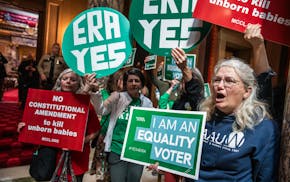While the financial ax fell on most state agencies and functions this week, Gov. Tim Pawlenty spared education. In fact, the governor built in ways for K-12 to receive modest increases, demonstrating a visionary view: Even in the worst of economic times, education is an investment in the future.
Pawlenty proposed a K-12 spending package that could send an additional $156 million to public schools next year, about 2 percent above current spending levels. Those funds would come with strings attached -- schools would have to meet student performance standards and change teacher pay structures to get the money.
The largest portion of the proposed increase, $91 million, would be set aside for school districts that meet achievement goals. They could receive up to 2 percent per pupil for students who meet proficiency levels on statewide tests or show progress toward those goals. With several levels of proficiency and progress built into the formula, most districts would get at least the 1 percent increase, with the potential of doubling to 2 percent on the progress students make from year to year.
The governor also wants to expand and make permanent one of his pet projects -- the Q Comp program that encourages districts to adopt alternative, pay-for-performance salary schedules for teachers. Now a voluntary program with about 45 districts and individual schools participating, the proposed budget would use about $41 million to extend the extra payments to all districts and make the program mandatory.
Participating districts would receive an additional $300 per pupil to adjust their pay schedules and provide staff development. Q Comp has worked well for many districts and merits expansion to move districts away from the steps-and-lanes seniority pay system.
Although there is much to praise in the governor's proposal, several provisions need more scrutiny. The administration would delay or shift $1.3 billion in state aid to school districts. This budget-balancing tool has been used in the past and can be effective if payments are not held up too long. But if school officials borrow money to cover a shifted payment, interest becomes an added expense. And some district officials would argue that their budgets are still being hurt by similar shifts made several years ago.
Some school district leaders are concerned that the extra funding would do little to address projected budget shortfalls because the money would come for specific purposes. Instead, they want the flexibility to use any additional funds in ways that can avoid budget cuts.
Those concerns should be addressed as legislators study the details of Pawlenty's proposal and use it to start budget discussions. As those talks unfold, more details will emerge on the level of funding Minnesota can expect from a federal stimulus package. In the current U.S. House plan, Minnesota could receive more than $1 billion for general revenue aid, school construction and special education.
On balance, the governor should be commended for his general approach to K-12 spending. His willingness to devote more money to education -- even as state revenues are falling and tough budget cuts must be made -- represents smart, forward thinking. By making K-12 an investment priority in tough economic times, he sends a strong message about the need to develop one of the state's most important resources: brainpower.
Pass guardrails for HCMC governance changes

Minnesota needs an ERA that includes gender and reproductive freedom

Legislature must clarify sex, gender before putting an ERA before Minnesota voters

Legislature must act — properly — on Uber and Lyft before adjourning
